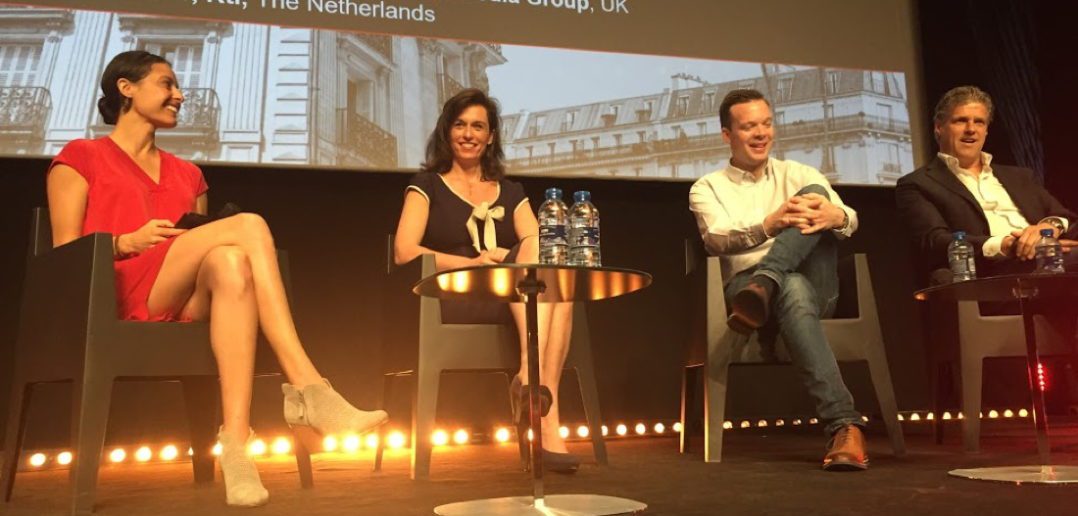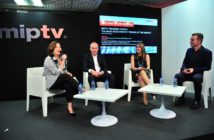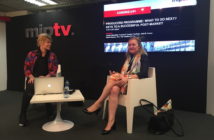MIPTV’s « When media agencies become production powerhouses » (shown above) and « Superpanel: Turning Brands into Content Studios » panels both take on the question of brand (and oftentimes agency) involvement in content, from how agencies can work as executive producers with broadcasters and production companies, to how brands approach content creation (and ultimately distribution).
« When media agencies become production powerhouses » was moderated by Videoink founder/CEO Jocelyn Johnson and featured Samantha Glynne, Global VP Branded Entertainment, at Fremantle Media; David Fletcher, Commercial Director Global Investment, Omnicom Media Group; and Ton Rozestraten, Chief Commercial Officer, RTL Nederland.
Advertiser-funded programming covers a wide range of activities that tie brands or agencies to content, and on-air slots are increasingly sold to media agencies in exchange for TV content financing. But in addition to acting as production funds, are media agencies willing to play the role of executive producer? What happens to rights ownership for other players?
At Fremantle, Glynne works directly with advertisers and brands, integrating them into shows. She also works with media agencies to see about financing shows through their production funds. In the Netherlands, RTL — represented by Rozestraten — is the market leader in Holland, working with agencies and advertisers to raise revenue. Finally, on the ad side, Fletcher said Omnicom spends about $50 billion of client money with media vendors.
Johnson began by asking Glynne how she perceives the agency/broadcaster relationship.
« The first thing to understand is the difference between working with agencies as financiers and working with them to integrate brands, » said Glynne, who called branded entertainment « a huge cover-all for anything related to brand and agency funding. »
In reality, agency-driven executive production and brand integration are treated as separate divisions, though Glynne conceded they are sometimes cross-bred. In addition, media agency financing is more complicated as platforms diversify and agencies realise they can score IP, too. (More on this in the second part of this post.)
« Depending which media agency you work with, and each territory, they all seem to have a different policy. We’re open to discussions, » Glynne added, noting that X Factor and Got Talent are supported by such relationships in certain markets. « We are open to working with a partner if our show gets on air, and in more territories. If our IP can travel… it only helps business. »
On the broadcaster side, Rozestraten is more measured. « I’m hesitant. I’m holding back on those kind of deals. » What it comes down to is inventory availability and creative relevance: « Some months we’re not sold out; we have to be careful what we are promising to clients, that we can deliver. If we do such a deal, it has to be extra money. We have to deliver it, look into the programming schedule and have close contact with the content department [to see]if they are willing to accept the show. »
Fletcher, representing agency land, agreed. « It has to work for the broadcaster. Essentially they’re paying for a show in their inventory. If they’re giving up inventory that otherwise would’ve been cashed to them, it’s still at significant cost. You have to look at the economics from that point of view. »
He added, « We’re quite pragmatic about that. We might say, ‘this market is not good for this type of business’. The three parties of us sitting here all need to see a benefit, and it can’t be an agency strong-arming a broadcaster and saying, ‘we think you should take the show because we spend so much money’. It has to be something that is [helping] his bottom line. »
To sweeten the deal in opening conversations, « it’s nice to go in with a well-recognised show, » Fletcher added. Once that moves through, and provided the relationship works well, you can start treating content as commodities—or as Fletcher put it, quoting a colleague, « go to a broadcaster with a show about a goat herder in Lithuania. »
Johnson observed that on one side of the spectrum, you have strictly-financier relationships; on the other side, there are the agencies that want to own IP, with a wide middle ground in between. What aspect of this is tricky for the production company?
« For a big production company like Fremantle, IP is our core business, » said Glynne. « People have referred to media agency deals as a necessary evil to get shows on air, but it’s not the ideal way. We’re happy to talk about sharing [IP], but distribution is key. »
Essentially, rights issues and fees aren’t so worrying; it’s a negotiation. But « creative involvement is more questionable — whether an agency wants to come on as a creative producer is on a case-by-case basis, » she said.
From a Fremantle perspective, this is understandable: « We’re in 31 territories and we want to use our production companies to make the format in those territories, » said Glynne. A format that travels — even if the IP is shared — boosts the wins for everyone. She used the example of talking to RTL about a format, which, if successful in Holland, can easily migrate to other territories.
As Fremantle cosied up, RTL reciprocated, with Rozestraten later saying, « If an agency’s coming with a format and tries to sell it, we want to know what production company is behind it. Not every production company is able to make the kind of show we need. If the production company is screwing up, the show doesn’t travel at all. »
« It’s not our business, » said Fletcher. « It’s a mistake if we try to be something we’re not. Let’s concentrate on what we’re good at: Planning and investing our company’s money wisely, and leave production to the people who do it best. » He also said that when agencies talk to production companies like Fremantle early on, ideas tend to be richer and have more legs.
Perhaps this reassured Rozestraten, but he reiterated the importance of a media agency bringing a value add. « If a media agency brings extra money on board and the show can travel a little bit faster, then it could work out. But again, the content department will decide. If I only have a commercial relationship with an agency on the table and the programme directors are not believing in the format, the show won’t be on air. »
« The win-win situation is when agencies, production companies and broadcasters go in as partners, » said Glynne. « We all agree, we want this to work, we want this to travel. I’d rather have a small piece of a hit than a big flop. »

Next, we attended « Superpanel: Turning Brands into Content Studios. » It was moderated by Campaign’s global brand director Adrian Barrick, and included PepsiCo Creators League Studio‘s GM, Louis Arbetter; Wargaming project manager Valeriya Tsygankova; and Marriott International‘s VP of global creative & content marketing, David Beebe.
Brands are under growing pressure to not just underwrite content but behave as content, but the bar is high for standing out in a content-saturated world. Still, there are visible successes, as Barrick pointed out at the session’s outset: « Some would argue the Lego movie was the best ad ever made, grossing $468m in ticket sales alone. »
But it’s also such successes that get brands wanting to run before they’ve even crawled.
« We’ve had some brand teams come to us and say ‘I want 3 feature length films out of the gate' » and shunning TV, said Arbetter. « You need to get them to understand you can’t turn it all the way up to 11. »
At PepsiCo’s Creators League Studio, « We go upstream into their strategy and the story they want to tell. Some of our brands are used to, ‘what is the summer season story I want to tell?’ They need a larger story, » Arbetter said. Once that’s identified, the team can decide how social, long-form, TV or other opportunities can play a role.
Illustrating that, Beebe spoke to Marriott’s ambition to « own travel »: « All our content … should really inspire people to travel » before selling hotel rooms, he said.
« With the scripted films we did of 20-30 minutes, our strategy was to move away from traditional marketing, which was selling features and benefits, » Beebe went on. « We use storytelling to showcase that without saying it—the rooms, the food and beverage experience. »
Marriott’s high-touch films were shot half in a hotel, half in the city. « The hotel was a character » in a wider story about the city, which sparks wanderlust, Beebe said. « The brand was just there, authentic to the story. »
They also created sales packages to reinforce both emotional connections and a sense of service. The sales package for its French Kiss film included a good Marriott rate, plus a meeting with the general manager, and a private tour of sites where it was shot (like Paris’ Eiffel Tower).
« Now our films are bringing money back in, so we’re covering the cost of them, » said Beebe. « Because we produce in a way that the brand is just part of the story, a lot of distributors don’t view it as branded content. » Instead, it gets licensed as original content the only happens to come from a brand. (Though we can’t help but wonder what RTL’s Rozestraten would have said.)
Arbetter touched upon the many opportunities technology provides, calling VR interesting and AR a space with a lot of opportunity. But PepsiCo doesn’t just do things because they’re new; « even existing platforms like Facebook 360, we’re building content just for that, » he said. « I don’t think some of the existing technology is fully realised in terms of how we can tell a story. »
Barrick praised how Empire’s latest season will be done mobile-first, a project PepsiCo played a critical hand in, which PepsiCo’s vp-marketing and cultural connections Adam Harter discussed when the brand won Brand of the Year today.
« Everybody says certain things—like ‘I want it to be mobile-first’, » Arbetter laughed. « There’s a difference between writing it in a brief and actually having the understanding to bring it to life effectively. Some of the work we do with Empire does a great job of truly being mobile-first because, in fact, it’s not available anywhere else. »
Some briefs boast ambitious goals but lack commitment to see it through, including from an investment perspective, he added.
Referring to Wargames‘ own technological activities, Tsygankova said, « We use VR to give our players the opportunity to feel like they’re sitting in a tank, looking around. » Augmented reality is also used in a separate app, where people can use an existing shot of a known area and put a ship in it. « We use it for fun, and entertainment and to give the opportunity to spread the word about us. »
« The CMO and CTO should be best friends, tech and marketing are tied so closely together now, » Beebe praised. « One of the coolest technologies we’ve used in our real-time social media command centres is called Hypersocial. In Marriott’s case, we geofence all 6700 hotels to capture all conversations taking place on social, public conversations. It’s a whole system platform that alerts you. »
Examples of conversations Hyper captures can include someone tweeting « enjoying the wedding » or « having a great time at the pool » from a Marriott location, « whatever it may be, » Beebe said. « They may not tag us, but because of this technology we can capture that and make a decision about what to do »—like send the tweeter a bottle of champagne, poolside, then see if they reply.
And they usually do. Marriott gets an 82 percent or higher response rate when it engages with customers via Hypersocial.
« That’s another piece of content. Even though it’s social, it’s more content being developed, » said Beebe.
As we wound down, panelists shared their views of how best to facilitate content productions with or as a brand.
« We’re the bridge to the creative community. Whatever brand needs come through the door, we help refine and define those stories, we’ll go to the right storyteller for that brief, » said Arbetter. For example, when Gatorade wanted to tell real-life stories about athletes, it was combined with documentary filmmaker David Darg.
« When the right storyteller is matched to the right brief, you get great results, » he said. Gatorade’s campaign, Win from Within, was ultimately accepted to the Tribeca Film Festival. « How it’s done is the trick. »
Tsygankova touted the importance of creating a single cycle in which fans play a critical role. For Wargames’ films, « we work in close connection with players, » she said. « If they’re interested in a special ship, video production » facilitates that. « We’re never separated; we’re totally included in one cycle. »
« What’s changing is the model and how content’s being produced, » said Beebe. « People who say ‘mobile-first’ or ‘TV’s dead’, I don’t believe in that. Great content will get watched. You need to market it. »
He said one of the biggest mistakes brands make is that they fail to invest in marketing. « But you can bring a brand, prod company and producer together to tell a story, » Beebe went on. « What’s new is, brands realise that by investing in those projects, they can actually be a part of it, own IP and actually start to build a media business versus just renting an audience. »
He concluded, « We’re kinda going full circle, right back to soap operas and P&G. »




